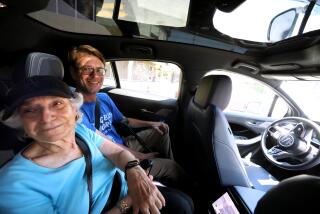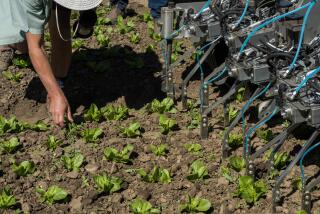4 Automated Cars Finish Race in Desert
PRIMM, Nev. — Four driverless vehicles outfitted with lasers, radar and GPS conquered a grueling 131-mile course in the Nevada desert Saturday, achieving a milestone in robotics that will win one of the teams a $2-million prize from the Defense Department.
“You really have seen history made,” said Anthony Tether, director of the Defense Advanced Research Projects Agency, which sponsored the race. “We have a winner.”
It was unclear, however, who that was.
Stanford University’s converted Volkswagen SUV, Stanley, crossed the finish line first -- ahead of Carnegie Mellon University’s two Humvees and GrayBot from Metairie, La. -- and one robot was still on the course when the race was stopped for the day because of approaching darkness.
The remaining vehicle, TerraMax, a 37,000-pound truck from Oshkosh, Wis., is scheduled to finish today before the winner is certified and the $2-million check presented. A winner couldn’t be declared immediately because start times were staggered and several vehicles were purposely paused for various reasons. Pauses didn’t count against a robot’s time, but deducting the pauses from elapsed time was proving complicated, race officials said.
Tether compared the successful completion of the race to the Wright brothers’ flight at Kitty Hawk a century ago.
Their airplane “went 100 feet,” Tether said, but the robot cars cut across a large swath of desert outside Primm, a town that is best-known as a gambling stop for Californians who don’t want to drive 35 more miles to Las Vegas.
In the first DARPA Grand Challenge, last year, the best-performing robot traveled about seven miles. Contestants crashed, burned and tumbled into bushes.
This time, the 23 robotic vehicles logged more than a thousand miles collectively. Contestants attributed the improved showing to improved technology and their own increased familiarity with it.
The award goes to the team that builds the autonomous vehicle that first negotiates a complicated course using only onboard electronics such as lasers, cameras, radar and global positioning systems -- no humans, including by remote.
Stanford’s vehicle rolled over the finish line Saturday a little over seven hours after it set out on a Mojave Desert course that ran through freeway underpasses, over cattle grates, around switchbacks and up 1,000-foot Beer Bottle Pass in the Lucy Gray Mountains.
Its time was three hours ahead of the DARPA deadline and 14 minutes ahead of the second vehicle to cross the finish line, Carnegie Mellon’s Highlander.
“We had a good day,” said Sebastian Thrun, one leader of the Stanford Racing Team.
The long-range goal of the competition, DARPA officials say, is to produce vehicles that can operate in war zones and other dangerous areas. Congress has told the military to make 30% of its vehicle fleet autonomous by 2015.
Thrun envisioned nonmilitary applications.
“The vision behind all of this is to make cars drive safer,” he said, noting that robotic systems that automatically steer out of the way of hazardous situations could save many lives.
Eighteen vehicles broke down Saturday, blowing tires, running off track or losing information from sensors.
The most thrilling crash was when Caltech’s vehicle, Alice, ran off the course after about eight miles. It smashed into a concrete barricade in front of a flimsy wire fence, on the other side of which were dozens of spectators with cameras.
Alice’s kill switch was remotely activated before it reached the fence.
Each team was supplied with a set of GPS waypoints two hours before the race. The vehicles used sensors to avoid such obstacles as boulders and cliffs.
“The world hasn’t begun to dream about the applications of this great work,” said William “Red” Whittaker, leader of Carnegie Mellon’s Red Team.
The team’s Highlander took 14 minutes longer to finish than Stanley; its second vehicle, Sandstorm, which got the farthest last year at 7.4 miles, was 11 minutes behind that. GrayBot took four hours longer to finish.
The relative closeness in elapsed times of the top three vehicles made computations more delicate.
“The data is all there,” said Tether. It just needed to be checked and double-checked.
Stanford and the Red Team were considered favorites going in. Highlander went off the line first at 6:40 a.m., while hundreds of spectators huddled against a chilly wind.
As the race went on, and the contest settled into a three-team competition, it appeared Stanford had the faster vehicle. On several occasions, race managers had to pause Stanley because it was climbing up on Highlander’s rear.
Whittaker said it was apparent that Highlander “didn’t have the pedal on the high end.”
It was 40 minutes behind the pace he expected.
He didn’t know what caused the glitch.
“Only the machine knows that,” he said.
DARPA officials allowed the Stanford SUV to pass the Carnegie Mellon Hummer near the end of the race.
The course was most challenging near the end, in the long, narrow Beer Bottle Canyon, which is filled with twisting switchbacks and sheer drops of more than 100 feet. A cheer went up from Stanford’s blue-shirted fans when Stanley emerged safely from the pass.
“These are pretty magnificent performances, no matter what,” Whittaker said as Highlander appeared to fade behind Stanley. “Automation is going to be a winner today.”
As the lead vehicles cruised smoothly over the course, teams from Cornell University, UCLA and Princeton University fell by the wayside one by one.
One surprise was sentimental favorite CajunBot, many of whose team members had experienced Hurricane Katrina. The University of Louisiana at Lafayette vehicle, a MAX ATV normally used for duck hunting in bayou country, was among the last half a dozen robots left after much higher-profile contestants dropped out.
“We’re ecstatic,” said Scott Wilson, a team leader. “We’re probably the smallest robot left. This is the little engine that could.”
In the end, it couldn’t, and broke down.
More to Read
Sign up for Essential California
The most important California stories and recommendations in your inbox every morning.
You may occasionally receive promotional content from the Los Angeles Times.










